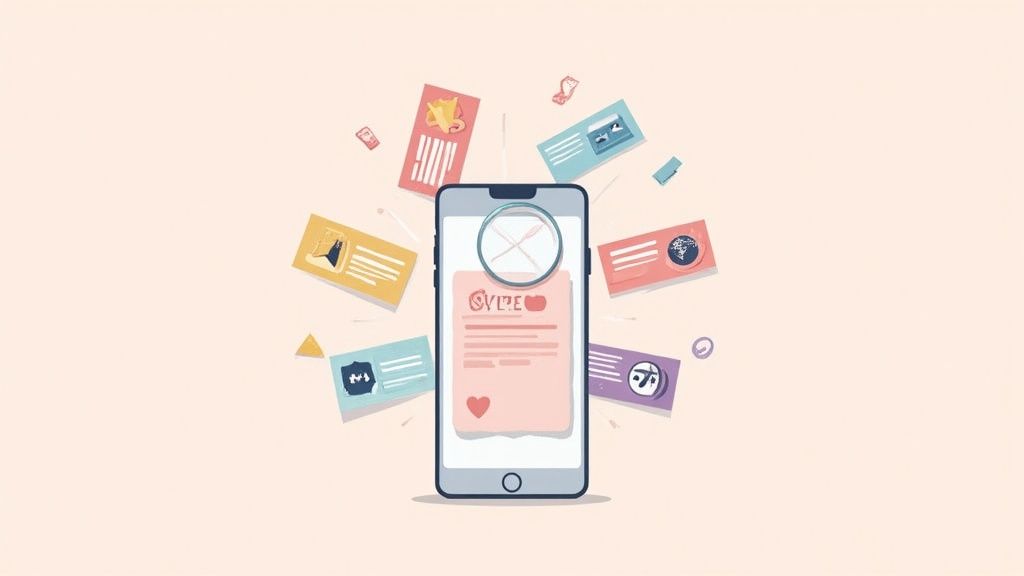10 Conversion Rate Optimization Techniques for 2025
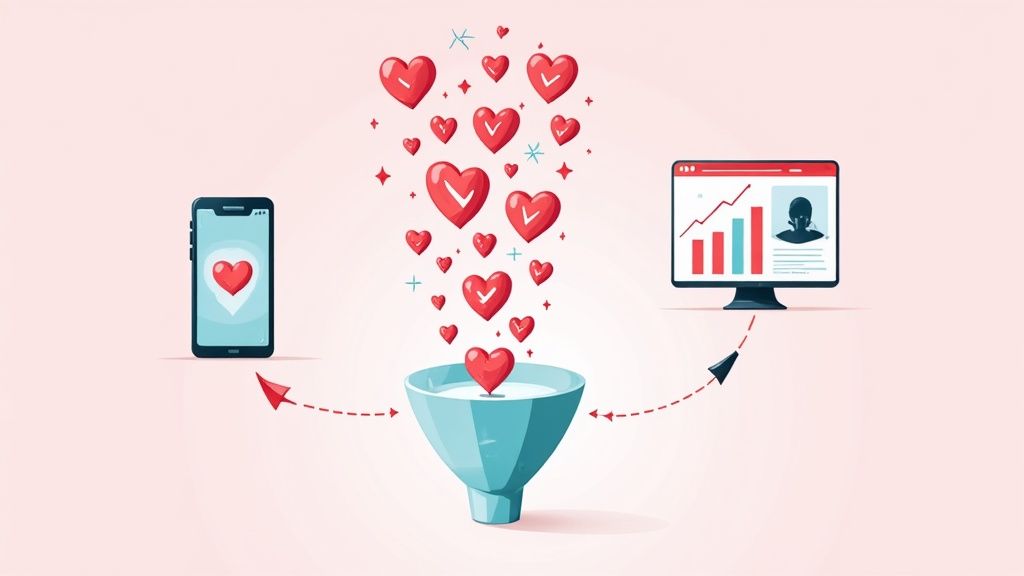
In the competitive world of digital engagement, whether you're building a sales funnel or perfecting an online dating profile, the ultimate goal is the same: conversion. Getting that click, that lead, or that "yes" to a date requires more than just a great product or a charming smile; it demands a deliberate strategy. This guide explores 10 proven conversion rate optimization techniques that apply universally, from maximizing e-commerce sales to ensuring your dating profile gets the attention it deserves.
We will dive into actionable methods that transform casual browsers into committed customers and casual swipers into genuine connections. To begin understanding the core principles, consider exploring a guide on conversion optimisation basics. By mastering these concepts, you can systematically improve your results and turn potential into reality.
For those navigating the dating scene, automating the initial outreach with tools like Auto-Swiper can free up your time to focus on what truly matters: applying these very optimization techniques to craft compelling conversations and build meaningful relationships. Let's explore how to make every interaction count.
1. A/B Testing (Split Testing)
A/B testing, or split testing, is the cornerstone of effective conversion rate optimization techniques. This method involves creating two versions of a single element (e.g., a profile picture or a headline) and showing them to different segments of your audience to see which one performs better. By systematically isolating variables, you can make data-driven decisions instead of relying on guesswork.
How It Works and Why It’s Crucial
The process is simple: version A (the control) is shown to 50% of your audience, while version B (the variation) is shown to the other 50%. You then measure which version achieves a higher conversion rate, whether that’s more matches on a dating profile or more clicks on a landing page button. For example, the Obama 2008 campaign famously increased donations by 49% just by testing different button text and images. This scientific approach removes bias and provides clear, actionable insights.
Actionable Tips for Effective A/B Testing
To get reliable results, follow these best practices:
- Isolate One Variable: Test only one element at a time (e.g., just the headline, not the headline and the main photo). This ensures you know exactly what caused the change in performance.
- Ensure Statistical Significance: Don’t end a test too early. Wait until you have enough data to reach a high confidence level (typically 95% or higher) to ensure the results aren't due to random chance.
- Focus on High-Impact Elements First: Start by testing elements that have the biggest potential to influence conversions, such as your primary profile picture, your bio’s opening line, or your website’s call-to-action.
The infographic below highlights the essential metrics you'll track during a typical A/B test.
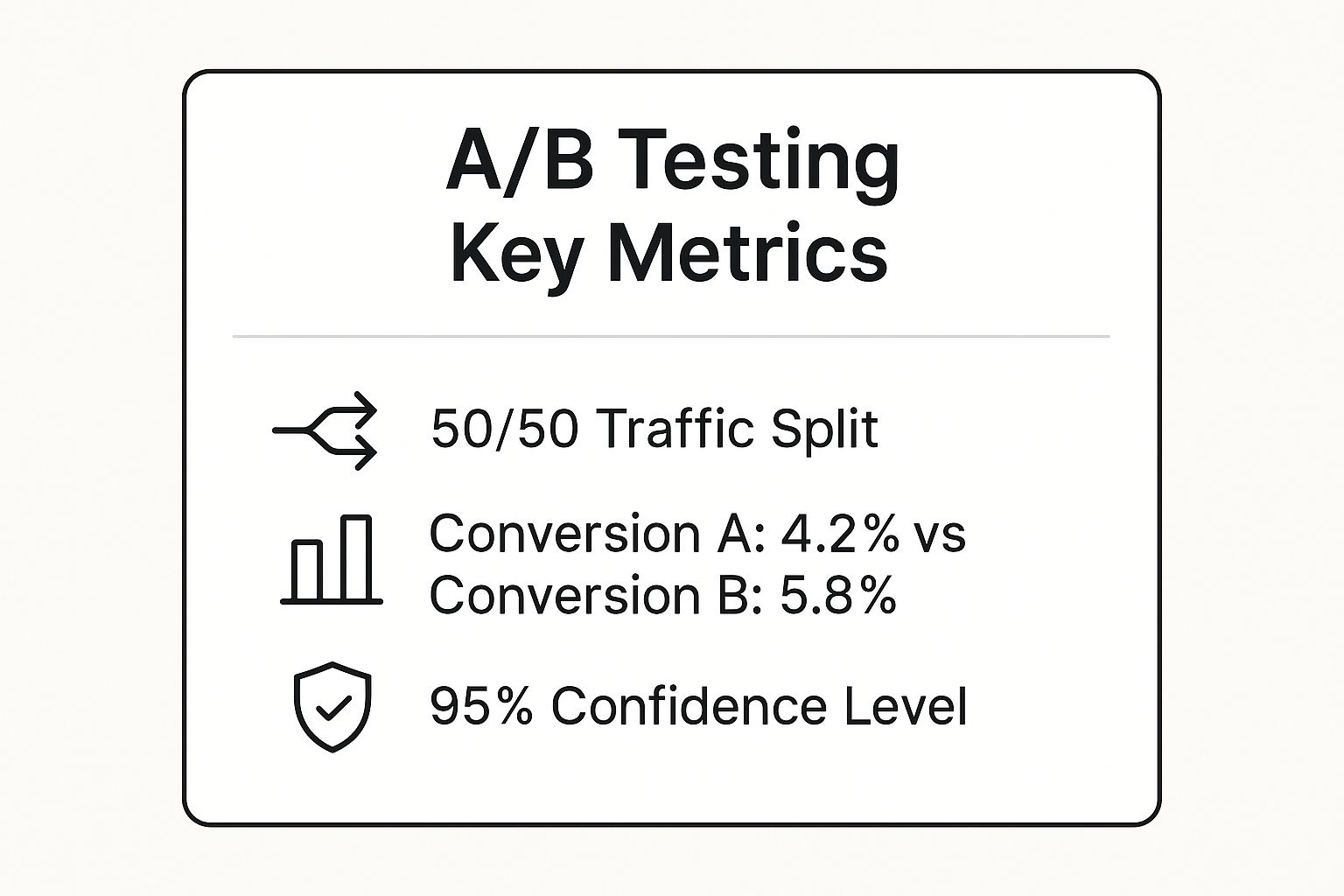
As the data shows, splitting traffic evenly and measuring the resulting conversion rates with high confidence allows you to definitively identify a winner.
2. Landing Page Optimization
Landing page optimization is a core conversion rate optimization technique focused on systematically improving the page where visitors first arrive. It involves refining every element, from the headline and copy to images and calls-to-action (CTAs), to guide visitors toward a single, specific goal. The aim is to create a frictionless experience that persuades users to take the desired action, whether it's signing up for a service, downloading a guide, or purchasing a product.
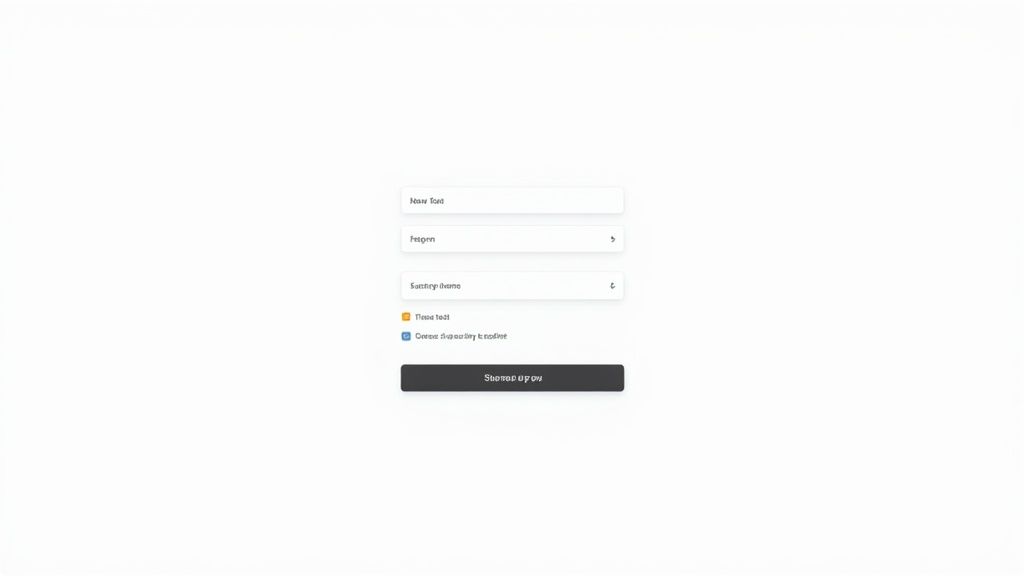
How It Works and Why It’s Crucial
A well-optimized landing page acts as your digital salesperson, working 24/7 to convert traffic into leads or customers. The process involves identifying and removing distractions while reinforcing the value proposition. For instance, Dropbox famously used a simple landing page with a clear value proposition and a short explainer video, which drove millions of signups. This focused approach ensures the visitor's attention is directed solely toward the conversion goal, significantly boosting performance. For a practical look at how these principles are applied, explore an example of a product landing page.
Actionable Tips for Effective Landing Page Optimization
To maximize your landing page's effectiveness, implement these proven tactics:
- Match Message to Ad Copy: Ensure your landing page headline directly reflects the promise made in the ad that brought the visitor there. This creates a cohesive and trustworthy user experience.
- Use High-Contrast CTAs: Make your call-to-action button stand out visually. Use a color that contrasts with the rest of the page to draw the user's eye and encourage clicks.
- Minimize Form Fields: Only ask for the information you absolutely need. Each additional field increases friction and can cause potential leads to abandon the form. Basecamp’s minimalist design is a prime example of this principle in action.
- Leverage Social Proof: Include testimonials, user reviews, or client logos prominently, preferably above the fold. This builds credibility and reassures visitors they are making a good decision.
3. Call-to-Action (CTA) Optimization
A call-to-action (CTA) is the element of your page or profile that prompts users to take a specific, desired action. CTA optimization, a critical conversion rate optimization technique, involves refining these prompts, whether they are buttons, links, or text, to maximize engagement. It’s the difference between a user passively browsing and actively converting, whether that means clicking "Get My Free Ebook" or sending a message on a dating profile.
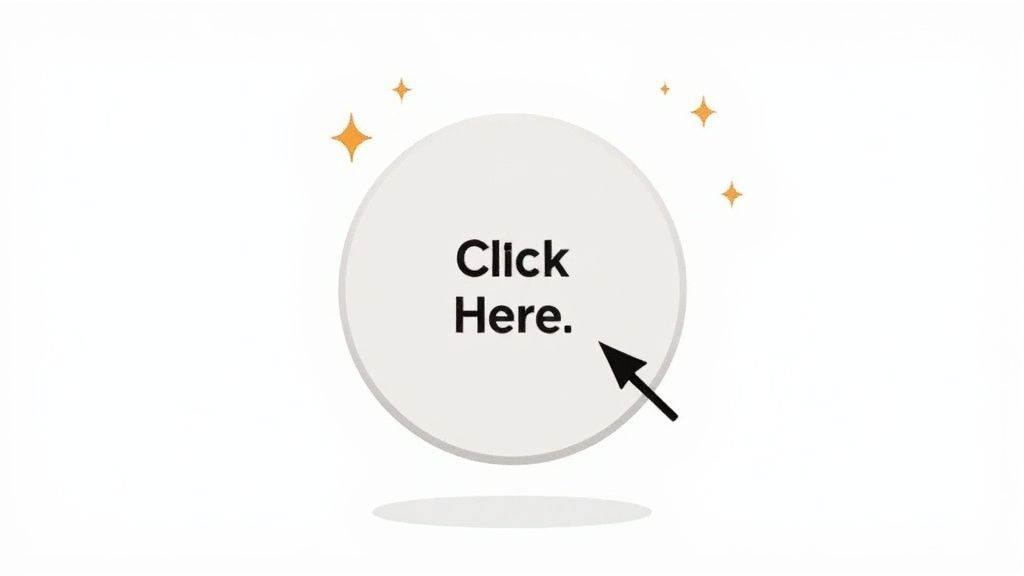
How It Works and Why It’s Crucial
This process involves systematically testing the language, color, size, and placement of your CTAs to discover what compels your audience to act. For instance, a simple change from a generic "Submit" to a benefit-oriented "Build my persona" can dramatically increase conversions because it frames the action around the user's gain. In online dating, this translates to crafting a profile bio that ends with an engaging question or a clear prompt to message you, directly guiding potential matches toward the desired next step instead of leaving them to guess.
Actionable Tips for Effective CTA Optimization
To create CTAs that convert, apply these proven strategies:
- Use First-Person, Action-Oriented Language: Phrases like "Get my free trial" or "Start my journey" resonate more strongly than generic commands. Use strong action verbs that create a sense of urgency and ownership.
- Prioritize Visual Prominence: Your CTA should stand out. Test contrasting colors from your brand palette to draw the eye, and ensure the button is large enough to be easily tapped on mobile devices.
- Strategic Placement: Place CTAs both above the fold for immediate visibility and below the fold to capture users who have scrolled through your content. This ensures you cater to both decisive and deliberate users.
4. Social Proof Integration
Social proof integration is a powerful conversion rate optimization technique that leverages the psychological principle of conformity. People are more likely to take an action if they see others doing it. This method involves showcasing evidence of your popularity, credibility, or trustworthiness, such as testimonials, user counts, or endorsements, to build confidence and encourage conversions.
How It Works and Why It’s Crucial
This technique works by reducing uncertainty and creating a sense of trust. When a potential customer sees that others have had a positive experience, it validates their decision-making process. For example, Booking.com uses this masterfully by displaying messages like “25 other people are looking at this property right now,” creating urgency and social validation. Similarly, a dating consultant’s website featuring glowing client testimonials with before-and-after success stories builds immense credibility, making new clients more likely to sign up.
Actionable Tips for Effective Social Proof Integration
To effectively integrate social proof, consider these best practices:
- Use Specifics: Instead of saying “many clients,” use precise numbers like “Helped over 200 clients find meaningful connections.” Specifics are more believable and impactful.
- Include Photos or Profiles: Pairing testimonials or reviews with a real photo and name of the person adds a layer of authenticity that text-only quotes lack.
- Showcase Recent Activity: Implement notifications like “Someone just signed up for our coaching package” to show your service is in active demand, which creates a fear of missing out (FOMO).
- Display Trust Badges: For agencies or consultants, showcasing certifications, media mentions, or “As Seen On” logos can quickly establish authority and trustworthiness.
5. Form Optimization
Forms are the final frontier between a user and a conversion, whether it’s a signup page, a payment process, or even filling out your dating profile bio. Form optimization is a critical conversion rate optimization technique focused on making this process as quick and painless as possible. By reducing friction, you directly increase the likelihood that a user will complete the form and convert.
How It Works and Why It’s Crucial
Every field you ask a user to fill out is a potential point of frustration or abandonment. The core principle is to streamline the experience by minimizing fields, clarifying instructions, and simplifying the layout. For instance, Expedia famously increased annual profits by $12 million simply by removing one optional field ("Company Name") from their booking form. Similarly, Marketo saw a 34% increase in conversions by reducing its form fields from nine to five. These examples prove that less is often more.
Actionable Tips for Effective Form Optimization
To turn your forms into conversion machines, apply these best practices:
- Ask Only for Essential Information: Scrutinize every field. If you don't absolutely need the information right now, don't ask for it. Every removed field can boost your completion rate.
- Use a Single-Column Layout: Studies by CXL Institute show that single-column forms are easier for users to scan and complete, leading to faster completion times and fewer errors.
- Implement Inline Validation: Provide real-time feedback as users fill out the form. A green checkmark for a correctly formatted email or a red warning for an invalid entry prevents frustration when they hit "submit."
- Clearly Mark Optional Fields: Instead of marking required fields with an asterisk, consider explicitly labeling the few that are optional. This shifts the user's perception, making the form feel less demanding.
6. Personalization and Dynamic Content
Personalization is a powerful conversion rate optimization technique that involves tailoring content and user experiences based on individual data like behavior, location, or demographics. Instead of a one-size-fits-all approach, dynamic content changes in real-time to match the visitor's context, making every interaction feel uniquely relevant and compelling. This boosts engagement by showing users exactly what they are most likely to want.
How It Works and Why It’s Crucial
This technique uses data to create a one-to-one connection. For instance, Amazon's recommendation engine, which is responsible for a massive portion of its sales, suggests products based on your browsing and purchase history. Similarly, in online dating, a profile that dynamically references a local event or a shared interest seen on a viewer's profile can dramatically increase response rates. This level of relevance builds immediate rapport and significantly lifts conversions by making the user feel understood.
Actionable Tips for Effective Personalization
To implement this technique successfully, start with small, impactful changes:
- Use Geotargeting: Customize your profile’s opening line or a website’s landing page offer based on the user's city or region. A simple "Hope you're enjoying the sunshine in [City Name]!" can feel incredibly personal.
- Leverage Behavioral Data: On a website, show product recommendations based on past pages a user visited. For dating, if your analytics show a high response from users with specific hobbies, tailor a version of your bio to highlight those interests more prominently.
- Personalize Calls-to-Action (CTAs): Instead of a generic "Learn More," use a dynamic CTA like "See Your Matches in [City Name]." This specificity makes the next step more enticing and relevant to the user's immediate context.
7. Page Load Speed Optimization
In a world of instant gratification, page load speed optimization is a critical yet often overlooked conversion rate optimization technique. This practice involves minimizing the time it takes for your landing page or website to become fully visible and interactive for a user. Since a user’s attention is fleeting, even a one-second delay can cause them to abandon your site, resulting in a lost conversion opportunity.
How It Works and Why It’s Crucial
A slow-loading page creates a poor user experience, signaling that your site is unprofessional or untrustworthy. Conversely, a fast page keeps users engaged and moving smoothly through your funnel. Major companies have proven its impact: Walmart saw a 2% conversion increase for every one-second improvement in load time, while Pinterest boosted conversions by 15% after reducing wait times by 40%. For dating profiles that link to external portfolios or websites, a fast-loading page ensures potential matches don't lose interest before seeing what you have to offer.
Actionable Tips for Effective Page Load Speed Optimization
To ensure your pages load instantly, implement these technical best practices:
- Optimize Images: Compress and resize images for the web without sacrificing quality. Use modern formats like WebP to significantly reduce file sizes.
- Enable Browser Caching: Instruct visitors' browsers to store static assets like logos, CSS, and JavaScript locally. This makes subsequent page loads much faster.
- Minimize HTTP Requests: Reduce the number of individual files your page needs to load. Combine CSS and JavaScript files and limit the use of third-party scripts.
- Use a Content Delivery Network (CDN): A CDN stores copies of your site on servers around the world, delivering content from the location closest to the user for maximum speed.
8. Mobile Optimization
With the majority of online activity, from dating app swiping to e-commerce shopping, now happening on smartphones, mobile optimization is no longer optional. This practice ensures your profiles, landing pages, and websites deliver a seamless and engaging experience on smaller screens. It’s a critical conversion rate optimization technique because a poor mobile experience directly translates to lost opportunities and high bounce rates.
How It Works and Why It’s Crucial
Mobile optimization involves creating a responsive design that adapts to various screen sizes, ensuring fast load times, and making navigation touch-friendly. Google’s mobile-first indexing prioritizes the mobile version of a site for ranking, making it essential for visibility. For dating profiles, this means ensuring your bio is readable without excessive scrolling and your photos load quickly. Similarly, for a web funnel, a mobile-first approach is key. For example, AutoAnything increased mobile sales by 51% simply by implementing a responsive design. This focus on the mobile user prevents frustration and keeps potential conversions engaged.
Actionable Tips for Effective Mobile Optimization
To maximize conversions from your mobile audience, implement these strategies:
- Use Large, Thumb-Friendly Buttons: Ensure all clickable elements, like call-to-action buttons or links, are large enough to be easily tapped with a thumb without accidentally hitting something else.
- Simplify Forms for Mobile: Keep forms short and simple. Use auto-fill capabilities and single-column layouts to make it easy for users to complete them on a small screen.
- Test on Real Devices: Emulators are helpful, but nothing beats testing on actual iPhones and Android devices to identify real-world usability issues. This ensures your user experience is truly flawless.
9. Psychological Triggers (Scarcity, Urgency, FOMO)
Harnessing psychological triggers is one of the most powerful conversion rate optimization techniques. This strategy leverages deep-seated human tendencies like scarcity (limited availability), urgency (time constraints), and FOMO (Fear of Missing Out) to compel immediate action. By tapping into these cognitive biases, you can significantly increase the perceived value of an offer and motivate users to convert before they lose the opportunity.
How It Works and Why It’s Crucial
These triggers work by creating a sense of anxiety that an opportunity will soon disappear. Scarcity implies limited supply, like Booking.com’s “Only 1 room left!” message, while urgency imposes a time limit, such as Amazon's "Limited time deal" countdowns. This approach short-circuits the user's tendency to procrastinate by making the cost of inaction feel higher than the cost of taking action. When users believe they might miss out, they are more likely to convert quickly.
Actionable Tips for Effective Psychological Triggers
To ethically implement these triggers, follow these guidelines:
- Use Authentic Scarcity: Ensure your scarcity is genuine. Artificially creating limitations can damage trust if users discover the claims are false.
- Make Deadlines Specific: Vague deadlines like "for a limited time" are less effective than concrete ones like "Offer ends in 24 hours." Specificity creates a more tangible sense of urgency.
- Combine with Value: These triggers amplify your value proposition; they don't create it. Ensure the underlying offer, whether it's your dating profile or a product, is genuinely appealing.
10. Checkout Process Optimization
Checkout process optimization is a critical conversion rate optimization technique focused on streamlining the final steps a user takes before completing a purchase. This method reduces friction and cart abandonment by simplifying forms, offering clear payment options, and building trust. A clunky, confusing, or lengthy checkout is a major reason potential customers abandon their carts, making this a high-impact area for improvement.
How It Works and Why It’s Crucial
This process involves analyzing every step from the shopping cart to the final confirmation page and removing any unnecessary barriers. For example, Amazon’s patented 1-Click purchasing eliminated nearly all steps, drastically boosting conversions. Similarly, integrating options like Apple Pay or PayPal's guest checkout caters to user preferences for speed and security. By minimizing the effort required to pay, you make the conversion feel seamless and easy, significantly increasing the likelihood of completion.
Actionable Tips for Effective Checkout Process Optimization
To refine your checkout funnel and capture more conversions, implement these best practices:
- Offer Guest Checkout: Don’t force users to create an account. This is a major point of friction, and allowing a guest option can instantly lift conversion rates.
- Minimize Form Fields: Only ask for essential information. Every extra field you require a user to fill out is another chance for them to abandon the process.
- Display Security Badges: Prominently show trust seals from names like Norton or McAfee and clear "Secure Checkout" messaging to reassure users their financial data is safe.
- Show Progress Indicators: Use a visual progress bar (e.g., Step 1 of 3) to show users where they are in the process. This manages expectations and reduces feelings of being overwhelmed.
Conversion Rate Optimization Techniques Comparison
| Item | Implementation Complexity | Resource Requirements | Expected Outcomes | Ideal Use Cases | Key Advantages |
|---|---|---|---|---|---|
| A/B Testing (Split Testing) | Moderate to High (statistical knowledge needed) | Requires significant traffic and analytics tools | Data-driven insights, measurable ROI, clear winners | Testing multiple elements, optimizing conversions | Reduces guesswork, provides statistical confidence |
| Landing Page Optimization | Moderate | Design, copywriting, ongoing testing | Higher conversions, better user experience, reduced bounce rates | Improving key entry pages for focused conversions | Clear messaging, improved ad spend ROI |
| Call-to-Action (CTA) Optimization | Low to Moderate | Minimal design and copy edits | Immediate impact on conversions, quick wins | Enhancing buttons, links, prompts for actions | Easy to test and implement, low cost |
| Social Proof Integration | Low to Moderate | Content creation and updates | Builds trust and credibility, reduces anxiety | Adding testimonials, reviews, endorsements to increase trust | Cost-effective, leverages psychology |
| Form Optimization | Moderate to High | Technical skills for form design | Higher completion rates, reduced abandonment | Improving form completion for lead generation | Better UX, lower cost per lead |
| Personalization and Dynamic Content | High | Advanced data collection, ML, APIs | Higher engagement, better conversions, increased LTV | Tailoring content based on behavior and preferences | Competitive advantage, improved relevance |
| Page Load Speed Optimization | High | Development, infrastructure adjustments | Improved UX, reduced bounce, better SEO and conversions | Enhancing site speed to retain users | Decreases bounce rates, improves search rankings |
| Mobile Optimization | Moderate to High | Design and development for various devices | Higher mobile conversions, improved UX on mobile | Catering to growing mobile user base | Future-proof design, better search rankings |
| Psychological Triggers (Scarcity, Urgency, FOMO) | Low to Moderate | Copywriting and design adjustments | Immediate action, higher conversion rates | Creating urgency or scarcity to motivate users | Effective motivation, reduces decision paralysis |
| Checkout Process Optimization | Moderate to High | Development and payment integrations | Reduced cart abandonment, higher completion rates | Streamlining purchase funnel for e-commerce | Improves satisfaction, increases revenue |
Turn Theory into Action and Clicks into Connections
Mastering conversion rate optimization techniques is not a one-time task; it's a continuous cycle of testing, learning, and refining. Throughout this guide, we've explored a powerful arsenal of strategies, each designed to transform passive viewers into engaged participants. From the analytical precision of A/B testing your profile pictures to the psychological pull of a well-crafted call-to-action in your bio, every element matters.
The journey from a simple online profile or landing page to a high-performing conversion machine is built on understanding your audience and systematically removing friction. The techniques discussed, such as landing page optimization and mobile-first design, are not just abstract marketing concepts. They are practical tools for creating a seamless and persuasive user experience, whether your goal is to secure a match on a dating app or guide a customer through a sales funnel.
Your Path to Higher Conversions
The true value of these conversion rate optimization techniques lies in their application. Merely understanding the theory behind social proof or checkout process optimization is not enough. The key is to start implementing, measuring, and iterating.
To get started, focus on these core takeaways:
- Embrace Data-Driven Decisions: Stop guessing what works. Use A/B testing to gain concrete evidence about which headlines, images, or calls-to-action resonate most with your target audience.
- Prioritize the User Experience: Every optimization, from improving page load speed to simplifying forms, centers on making the user's journey effortless and intuitive. A frustrated visitor will never convert.
- Build Trust and Credibility: Integrating social proof and ensuring your digital presence is professional and secure are fundamental. Trust is the bedrock of any successful conversion, be it a date or a sale.
- Personalize the Interaction: Generic approaches yield generic results. Leverage personalization and dynamic content to make your audience feel seen and understood, dramatically increasing their likelihood of taking the next step.
Applying these principles consistently will build a more effective, engaging, and ultimately more successful online presence. For those navigating the demanding world of online dating, this means more than just a higher match count; it means creating more opportunities for genuine connection. By optimizing your profile, you are not just playing a numbers game; you are presenting the best version of yourself to the right people.
This systematic approach allows you to focus your valuable time and energy where it truly counts: on crafting compelling profile narratives and engaging in meaningful conversations. The initial effort you invest in implementing these conversion rate optimization techniques will pay dividends, creating a self-sustaining engine for success.
Ready to apply these optimization principles and supercharge your dating results? While you focus on crafting the perfect profile and messages, let Auto-Swiper handle the repetitive, time-consuming work of swiping. By automating the top of your funnel, you free up your time to connect with the high-quality matches you've earned. Visit Auto-Swiper to learn how our smart automation can become a core part of your dating optimization strategy.

